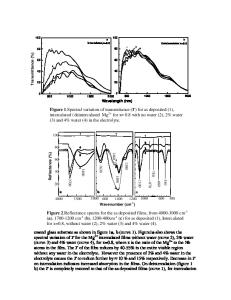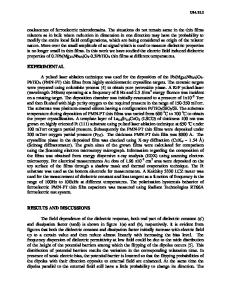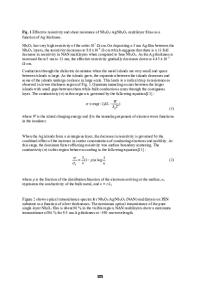Electrochromic Properties of Polycrystalline Nb 2 O 5 Thin Films with Mg 2+ Ions
- PDF / 123,105 Bytes
- 6 Pages / 612 x 792 pts (letter) Page_size
- 16 Downloads / 339 Views
0936-L10-01
Electrochromic Properties of Polycrystalline Nb2O5 Thin Films with Mg2+ Ions Gargi Agarwal, and G. B. Reddy Thin Film Laboratory, Department of Physics, Indian Institute of Technology Delhi, New Delhi, 110016, India ABSTRACT Sol-gel derived Nb2O5 thin films crystallize to a stable hexagonal phase on annealing at 600oC in air. These films have been intercalated with Mg2+ for the first time and the structural and the optical changes on intercalation have been reported. The ratio of Mg2+ and Nb ions x, is controlled by adjusting the interaction duration keeping the current density constant. On intercalation to x=0.6 the transmittance has reduced by 35% in the complete visible region. The FTIR spectra of intercalated films reveal the formation of Mg-O-Nb bonds, Nb-OH, Mg-OH and Mg-O bonds and also, presence of free water molecules in very small quantity. The coloration is completely reversible on deintercalation. XRD studies show formation of MgNb2O6 phase, when the films are intercalated using electrolyte of high concentrations (≥1.0 M). Keywords: Electrochromic, Niobium pentaoxide, Sol-gel, Magnesium, Intercalation.
INTRODUCTION
Electrochromic materials facilitate dynamic control of the throughput of radiant energy and play a significant role in energy efficient “smart” windows to control the heat load on buildings. Nb2O5 is one of the typical cathodic electrochromic materials like WO3, MoO3 and V2O5. Full potential of this material as an electrochromic material has not yet been explored. Nb2O5 is known to have various polymorphic forms like the H-phase, T-phase and the TT-phase and it exhibits a wide variety of properties depending on its crystalline modification [1]. The TT-phase is of particular interest for electrochromism. Polycrystalline Nb2O5 films have much wider optical modulation and better durability than amorphous films, a tendency quite different from the case of WO3 films [2]. Electrochromic studies in polycrystalline Nb2O5 have been reported with monovalent ions like Li+ or H+ [2]. However, Li salts are highly toxic and react strongly with air/moisture due to which their handling is a major challenge. Also the cost of these salts is very high and its natural abundance is very less. This has forced a search for alternate intercalant ions for large-scale electrochromic applications. The size of the Mg2+ ions (0.72Å) is close to that of Li ions (0.59Å) compared to that of Na+ ions (0.95Å), the next higher univalent alkali element to Li in the periodic table. Also the number of electrons injected in the film with Mg ions is double the number inserted with the same number of Li or any other monovalent ion. Also, the equivalent weight of Mg2+ (12gram/Faraday) is close to that of Li+ ions. It is well known that the magnesium salts are non-toxic, environment friendly, and are cheaper. Recently, there have been reports on the use of Mg ions as intercalant to obtain reversible electrochromic behavior in amorphous and crystalline MoO3 thin films [3] and V2O5 polycrystals
[4] and aero-gels. Thus, i
Data Loading...











